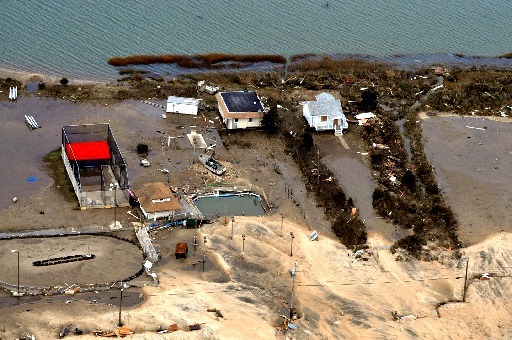Beach Nourishment Works, But Should Towns Rebuild?


DENVER —Beach nourishment works, according to a detailed survey of New Jersey homes damaged by Hurricane Sandy, researchers reported here this week at the Geological Society of America's annual meeting.
But protecting private property by replenishing storm-damaged beaches — projects that cost taxpayers billions of dollars — may be an exercise in futility, with the specter of sea level rise and climate change's effects on storms.
"Our barrier islands and our coastal areas are coming in for a time of severe trouble," said Harold Wanless, a coastal scientist at the University of Miami. "We truly have the risk of catastrophic chaos."
Save the Jersey Shore
Despite beach nourishment and a seawall to offer protection from powerful waves, Hurricane Sandy destroyed 18 homes in Sea Bright, N.J., last year, where Sandy's storm surge was among the highest in the state, said Adam Griffith, a coastal research scientist at Western Carolina University's Program for the Study of Developed Shorelines, who led the beach nourishment study. Many of the toppled homes sat on the ocean side of the seawall, with little defense from the storm tide.
But elsewhere in New Jersey, beach nourishment reduced the likelihood that homes were flooded during Sandy, Griffith and his colleagues discovered. The researchers combined several databases to gauge the effectiveness of beach nourishment in protecting homes from flooding, such as the Federal Emergency Management Agency's damage estimates, the U.S. Geological Survey post-Sandy coastal survey and Western Carolina's own records of Atlantic Coast beach nourishment projects.
Before Hurricane Sandy struck, New Jersey had 45 miles (72 kilometers) of nourished beaches and 75 miles (120 km) without beach nourishment. Nourished beaches have sand dumped or pushed onto the beach from elsewhere to widen the beach. Waves erode the added sand instead of destroying what's behind the beach, such as homes or hotels.
Get the world’s most fascinating discoveries delivered straight to your inbox.
All things being equal, if beach nourishment didn't work, then 37 percent of damaged homes would have been on nourished beaches, Griffiths said. (The 45 miles of nourished coast is about 37 percent of the total length of the New Jersey shore, he said.) But only 14 percent of flooded homes were on the nourished beaches. [Jersey Shore: Before and After Hurricane Sandy]
"The discrepancy is enough to make me think that there is something to this," Griffith told LiveScience. But the connection concerns him, because it could encourage local and federal agencies to continue building along vulnerable shorelines, instead of allowing beaches and barrier islands to advance and retreat naturally.
"Unfortunately, I think this could be used as evidence that beach nourishment works, because I agree that instead of developed shorelines, coastal retreat is the more responsible thing to do for areas of repetitive loss," he said.
Griffith now plans to conduct the same analysis to see how nourished beaches on New York's barrier islands fared during Hurricane Sandy.
Preparing for future storms
Whether or not beach nourishment saves homes, local, state and federal agencies need the power to plan for sea level rise and future storm damage, geologists said at the GSA meeting.
"It's like the Wild West out there right now," said Robert Young, director of the Program for the Study of Developed Shorelines. Young showed pictures of a Long Island mansion's new revetment, a boulder wall with rocks so big they only fit two on a flatbed semi.
"We have made a de facto policy decision we will attempt to hold the nation's shorelines in place," Young said. But beach nourishment is a never-ending commitment, he added, whether through adding sand, building new walls or elevating homes. "We need to decide who pays. The benefits are reached fairly locally, and we need to develop a funding mechanism that localizes that."
Both Wanless and Alan Benimoff, a geologist atthe College of Staten Island, offered plans for preparing for the next big storm, and battling sea level rise.
Their steps include stopping new infrastructure development on barrier islands, such as Miami Beach's planned $600 million investment in a refurbished sewage treatment plant on Virginia Key. Wanless said the barrier island could disappear by 2050 if sea level rises by 2 feet (0.6 meters) between now and then.
Wanless agrees with 2012 sea level rise estimates from the National Oceanic and Atmospheric Administration that predict parts of the Florida coastline will experience the most rapid and highest amounts of sea level rise in the United States in next 50 years. "Every model suggests we will be accelerating our sea level rise 1 foot [30 centimeters] per decade," he said.
Big buyouts
Benimoff said there are coastal and wetland areas in New York and New Jersey that should never have been developed. He recommends rezoning flood-prone areas to prevent new homes from being built and buying up existing homes, then turning these areas into parks.
More than 123 million people live in the United States' coastal counties, and the total value of insured private property along the Atlantic and Gulf Coasts is more than $4 trillion dollars, said Ilya Buynevich, a coastal scientist at Temple University in Pennsylvania. [Half of US Population Lives in Coastal Areas (Infographic)]
Wanless fears what might happen to coastal residents if insurance companies pull out of places like Miami-Dade County and people lose their homes to flooding from storms or sea level rise.
"We'll be like the Dust Bowl Okies, trying to find a place and be rejected everywhere," he said.
Email Becky Oskin or follow her @beckyoskin. Follow us @OAPlanet, Facebook & Google+. Original article on Live Science's OurAmazingPlanet.



